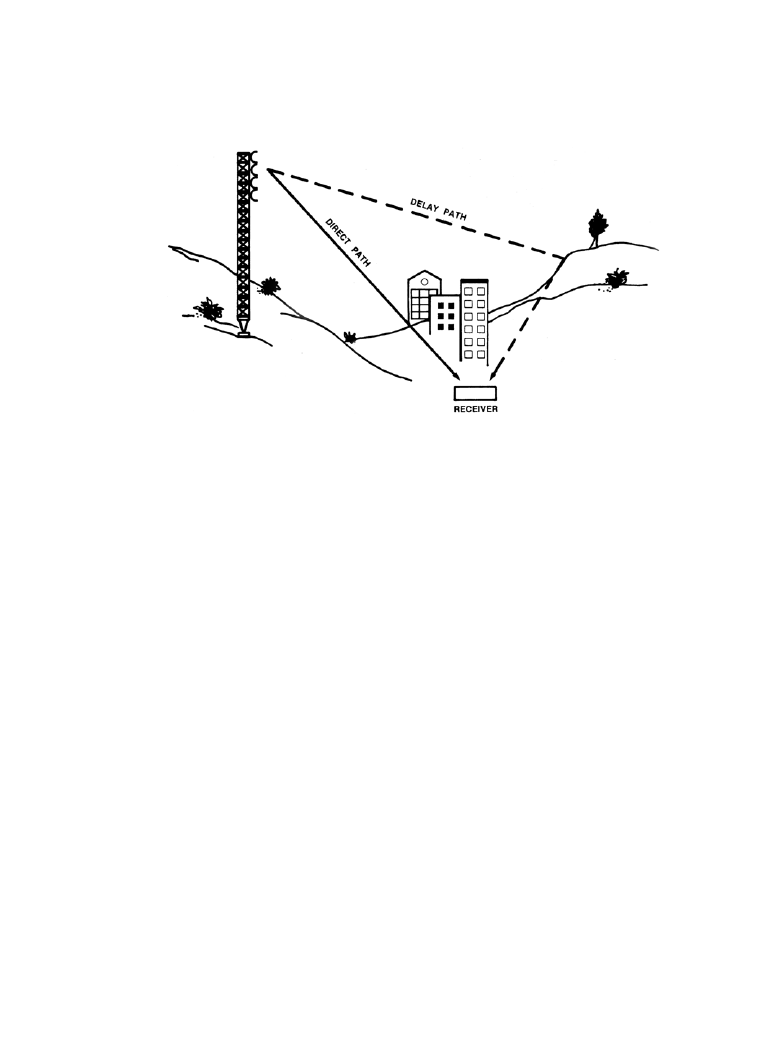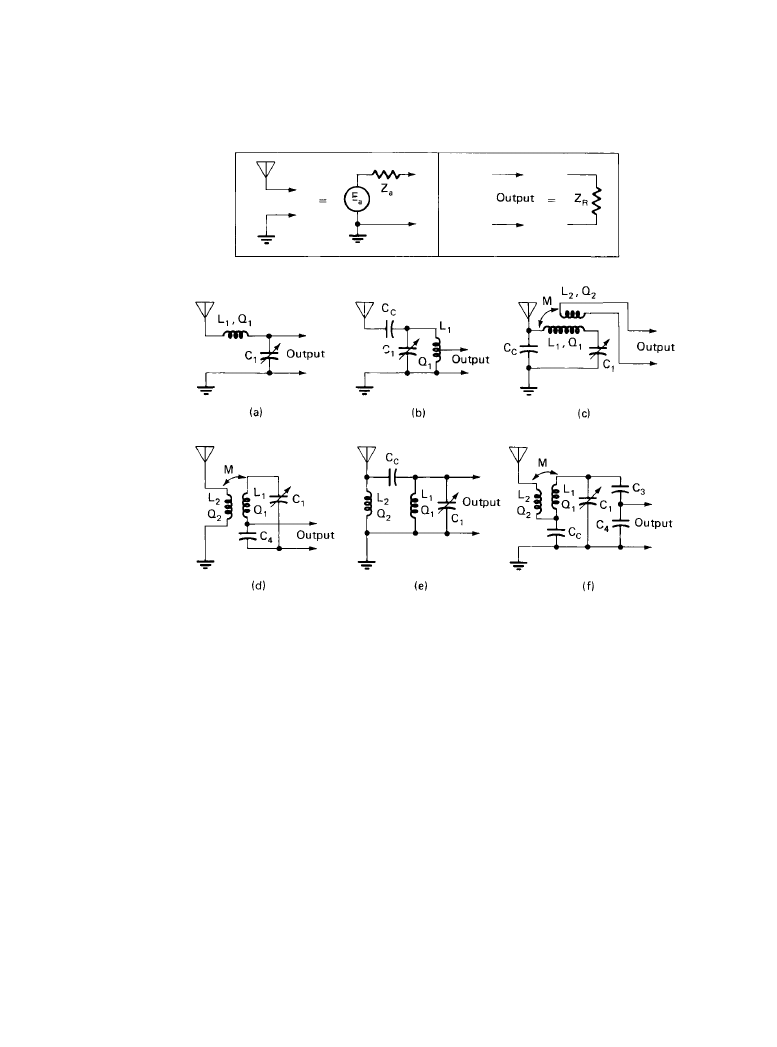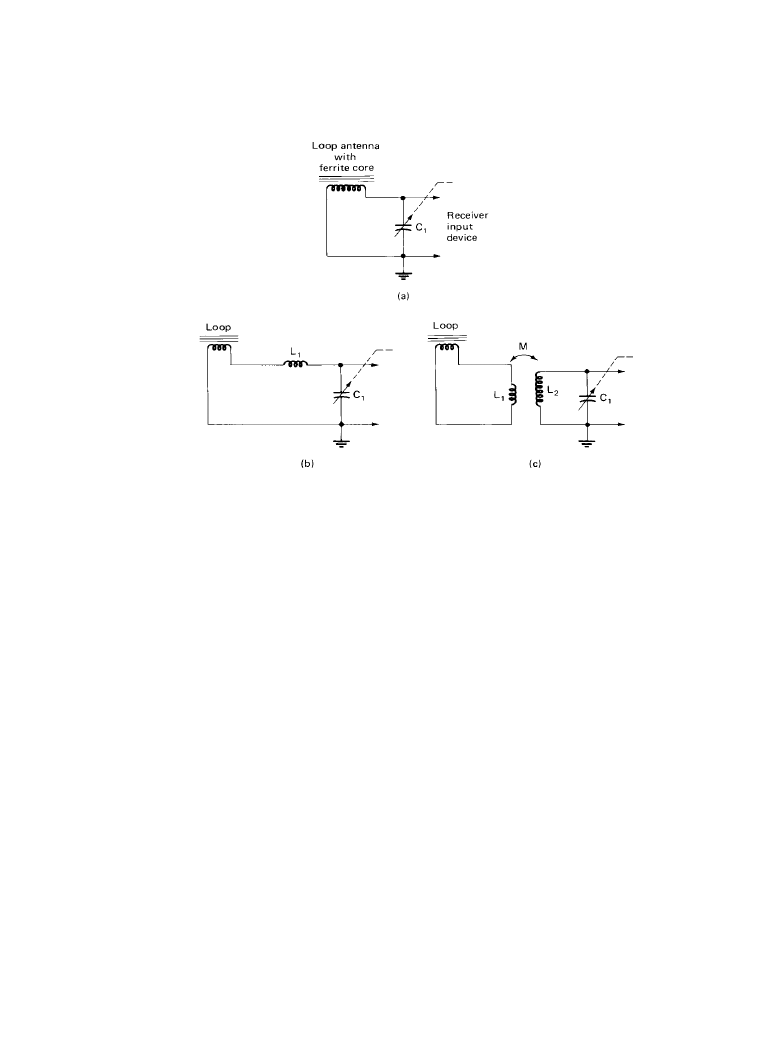ВУЗ: Казахская Национальная Академия Искусств им. Т. Жургенова
Категория: Книга
Дисциплина: Не указана
Добавлен: 03.02.2019
Просмотров: 21615
Скачиваний: 19

AM and FM Receivers 12-43
12.3.2 Radio Wave Propagation
Radio waves are electromagnetic energy that can be attenuated, reflected, refracted, and scattered
by changes in the media through which they propagate. Radio waves in free space have electric
and magnetic field components that are mutually perpendicular and lie in a plane transverse to
the direction of propagation. Radio waves travel at a velocity of about 300,000 km/s.
The received signal field is accompanied by noise generated as the result of natural sources
(electrical activities in the atmosphere and space) and/or artificial sources (other radio transmis-
sions and machinery of various types). In addition, the receiver itself is a source of noise. Electri-
cal noise limits the range and performance of radio communications by requiring a sufficient
signal strength at the receiver to overcome the undesired noise.
AM Band Propagation
AM broadcasting (530 to 1610 kHz) falls in the middle of the medium-frequency (MF) band,
which extends from 300 kH to 3 MHz. During daylight hours, ground wave propagation is pre-
dominate, and the effects of atmospheric noise are minimal. The receiver NF has little effect on
overall signal quality unless the antenna system is very inefficient. At night, however, sky wave
propagation is significant, permitting reception of signals hundreds or even thousands of miles
away Unfortunately, atmospheric noise is also greatest at night.
Fading at the receiver occurs in portions of a station's coverage area where both the ground
wave and sky wave are comparable in strength. Fading can become quite deep during periods
when the two waves are nearly equal. The ground wave will always reach the receiver through the
most direct route. The sky wave will arrive later in time, out of phase with the ground wave,
resulting in attenuation of the composite signal. Fading can also occur as a result of two or more
sky waves with different numbers of reflections combining at the receiver.
When fading is caused by two or more waves that interfere as a result of having traveled over
paths of different lengths, different frequencies within the transmitted spectrum can be attenu-
ated to various extents. This phenomenon is known as selective fading. It can result in severe dis-
tortion of the signal.
Noise-free AM reception is particularly difficult at night because of the tremendous amount
of noise present on the AM dial caused by sky wave interference from distant stations on the
same or adjacent frequencies. The only solution to this problem is to increase the signal strength
of the desired station at the antenna of the receiver. This essentially means that the effective ser-
vice area of an AM station will be restricted during nighttime hours to locations in which a
strong local ground wave signal is available.
FM Band Propagation
FM broadcasting (88 to 108 MHz) occupies a portion of the very-high-frequency (VHF) band,
which extends from 30 to 300 MHz. For greatest reliability, most VHF communication relies on
a line-of-sight path from the transmitter to the receivers. For this reason, FM transmitting anten-
nas are located on high towers, tall buildings, or mountaintop sites. The wavelength at FM fre-
quencies is sufficiently short that FM can penetrate automobiles and steel-frame buildings with a
minimum of loss. FM is not affected by nighttime sky wave interference. The propagation prop-
erties of FM radio are essentially the same from day to night.
FM is, however, affected by reflections of the transmitted signal that can mix at the receiver
and cause fading or distortion. The phenomenon is known as multipath (see Figure 12.3.2).
Downloaded from Digital Engineering Library @ McGraw-Hill (www.digitalengineeringlibrary.com)
Copyright © 2004 The McGraw-Hill Companies. All rights reserved.
Any use is subject to the Terms of Use as given at the website.
AM and FM Receivers

12-44 Radio Receivers
Reflections can be caused by mountains, steel-frame buildings, vehicles, and other objects. The
interference patterns set up as a result of multipath cause the signal strength to vary from one
location to another in an apparently random manner. It is often possible, for example, to improve
reception simply moving the antenna 2 ft or so (about 1/4 wavelength at FM frequencies).
The noise level at VHF is low compared to the MF band. Artificial noise can produce impul-
sive interference, but the use of hard limiting in receivers will eliminate most amplitude-related
noise. Interference from other FM stations can, however, produce noise at the receiver that usu-
ally cannot be stripped off by limiting.
12.3.3 Radio Receivers
The design of an AM or FM receiver is a complicated process involving a huge number of tech-
nical, economic, and perceptual characteristics. It is not enough for a receiver to perform well—
it must also meet a particular price point and respond to the needs (or wants) of the consumer.
Take, for example, the small, portable (“Walkman”-type) AM-FM radios available today. The
consumer wants a radio that is small and light enough to clip on a belt or slip into a shirt pocket.
The radio does not need to be feature-rich, but it must perform well without any external antenna
in a wide variety of working environments. The price point of the radio to consumers must be
below $20.
These specifications place enormous demands on the manufacturer. It is far easier to build a
large, heavy, feature-rich radio that uses an outdoor antenna, is powered from the ac line, and can
be priced upwards of $400 than it is to build the radio just described. The design of any AM-FM
radio for use by consumers is an exercise in compromise.
Figure 12.3.2
The causes of multipath in FM broadcasting. Distortion of the demodulated FM sig-
nal is related to both the direct-reflected signal ratio and the delay time of the reflected signal. Dis-
tortion increases as the signal ratio approaches 1:1, and as the secondary path delay increases.
Downloaded from Digital Engineering Library @ McGraw-Hill (www.digitalengineeringlibrary.com)
Copyright © 2004 The McGraw-Hill Companies. All rights reserved.
Any use is subject to the Terms of Use as given at the website.
AM and FM Receivers

AM and FM Receivers 12-45
Most radios today have been reduced to just a handful of LSI chips, or even a single VLSI
device. This dramatic move toward miniaturization has eliminated the traditional stages that
technicians are familiar with. Still, each stage exists in one form or another in virtually every
radio produced today. The circuits may be hidden on a slab of silicon, but they are there just the
same.
12.3.3a
Antenna Systems
The antenna must be designed to efficiently capture the transmitted signal and meet the physical
limitations of the receiver. This is easier said than done. The ideal antenna for an AM radio
would be a tall vertical wire or tower placed over a buried ground system. The FM equivalent
would be a high-gain Yagi antenna mounted 10 to 30 ft above the ground. Such antennas are
completely impractical for all but a few specialized, fixed installations. For most applications,
especially mobile or portable radios, compromises in antenna design must be made.
Antenna efficiency, impedance, bandwidth, and reception pattern are all a function of the
antenna dimensions relative to wavelength. A ferrite loop antenna is typically used for fixed and
portable AM radios, while a short (less than 3 ft) telescoping vertical antenna is normally used
for automobile AM radios. FM antennas usually consist of simply a length of wire (about 18 in)
that is tacked up on a nearby wall or run along a baseboard for fixed-location receivers, or a short
telescoping antenna for portable radios. Automobile FM radios use the AM auto antenna dis-
cussed previously. Shirt-pocket-sized radios simply rely on a length of wire run within the case
of the unit.
None of the antennas just discussed are particularly effective in converting radio waves into
electric signals. The constraints of space and cost have led manufacturers to sacrifice antenna
efficiency for a compact, convenient product. Supplemental external antennas are used only in
fixed applications requiring exceptional performance.
Antenna Coupling Network
Whatever form the antenna takes, it must be coupled efficiently to the first RF stage of the
receiver. The coupling network must exhibit low loss and adequate bandwidth to cover the band
selected (AM or FM). Until recently, it was customary practice to couple the antenna to a tuned
circuit connected to the input RF amplifier. Figure 12.3.3 illustrates several common coupling
arrangements. The examples differ mainly in the details of coupling. With ETR systems gaining
wide acceptance, mechanical tuning is becoming obsolete. Voltage-tuned capacitors (varactors)
are increasingly being used in radios today.
Whip Antenna
Nearly all automobile and some portable radios use whip antennas of about 2 to 3 ft in length for
both AM and FM reception. Seldom does the mounting surface resemble a plane. The problem
of coupling a whip optimally to the first active circuit is a difficult one. The antenna represents a
complex set of impedance, capacitance, reactance, and resistive components that vary with the
frequency and the surrounding physical structures. Still, given the ability to switch coupling cir-
cuitry between AM and FM bands, coupling to the RF amplifier can be satisfactory for reason-
able efficiency and bandwidth.
Downloaded from Digital Engineering Library @ McGraw-Hill (www.digitalengineeringlibrary.com)
Copyright © 2004 The McGraw-Hill Companies. All rights reserved.
Any use is subject to the Terms of Use as given at the website.
AM and FM Receivers

12-46 Radio Receivers
Loop Antenna
The loop antenna has been used in portable AM receivers for many years. Its response differs
from the monopole in that when the face of the loop is vertical, it responds to the magnetic field
rather than the electric field. Instead of being omnidirectional in azimuth (like a whip), the loop
responds to the cosine of the angle between its face and the direction of the desired transmission.
This yields the familiar figure-eight pattern, which makes the loop useful for direction finding
by providing a sharp null for waves arriving perpendicular to the face.
Loops used for AM broadcast reception incorporate a high-permeability (ferrite) core to
facilitate reduced size. Such a loop may be tuned by a capacitance and connected directly to the
input device of the receiver. Coupling is usually simple,. as illustrated in Figure 12.3.4. If the
loop has an inductance lower than that required for proper input impedance, it may be connected
in series with an additional inductance for tuning (as shown). If the loop impedance is too high,
the receiver input may be tapped down on the circuit.
Figure 12.3.3
Typical circuits used for coupling an antenna to a tuned resonant circuit. (
From [1].
Used with permission.)
Downloaded from Digital Engineering Library @ McGraw-Hill (www.digitalengineeringlibrary.com)
Copyright © 2004 The McGraw-Hill Companies. All rights reserved.
Any use is subject to the Terms of Use as given at the website.
AM and FM Receivers

AM and FM Receivers 12-47
12.3.3b
Filter Types
Filters are perhaps the most basic element of any receiver. If you are old enough to remember
“crystal radio” hobbyist sets popular some years ago, you will recall that these childhood toys
consisted of little more than a tuned circuit (filter) and detector. Although these sets have pretty
much been retired to museums, the principle still holds true.
Filter design has come a long way within the past 10 to 20 years. Filters that once were used
only in military applications because of their high cost are now produced by the tens of thou-
sands. With reduced costs have come better designs. Radios today include filters that designers
of consumer products could have only dreamed about 20 years ago.
Conventional filter design may be implemented using a number of different types of resona-
tors. The principal available technologies include:
•
LC filter
•
Electrical resonator
•
Quartz crystal filter
•
Monolithic quartz filter
•
Ceramic filter
The classical approach to radio filtering involved cascading single- or dual-resonator filters
separated by amplifier stages. Overall selectivity was provided by this combination of one- or
two-pole filters. This approach, however, had two distinct disadvantages: 1) the circuits were dif-
Figure 12.3.4
Examples of coupling circuits used for AM broadcast reception using a loop
antenna. (
From [1]. Used with permission.)
Downloaded from Digital Engineering Library @ McGraw-Hill (www.digitalengineeringlibrary.com)
Copyright © 2004 The McGraw-Hill Companies. All rights reserved.
Any use is subject to the Terms of Use as given at the website.
AM and FM Receivers